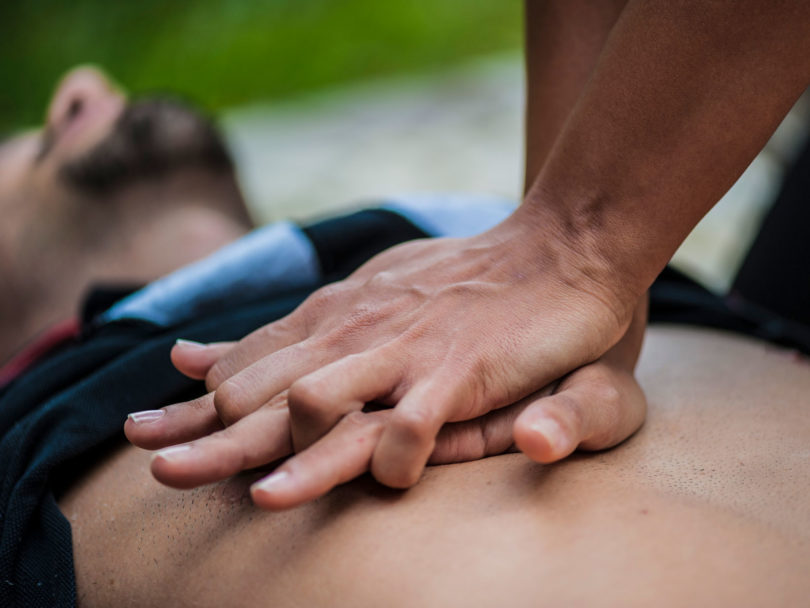Andrew Stonier was a 15-year-old freshman when he had a heart attack at school. His physical education teacher at his York County, Va., high school immediately started CPR – cardiopulmonary resuscitation. A school resource officer shocked his heart with an AED, or automated external defibrillator. Andrew survived, thanks in no small part to those quick actions. Each year, more than 350,000 sudden cardiac arrests take place outside of a hospital in the United States, according to the American Heart Association. Almost 90 percent of those people die. But if CPR is started in the first few minutes of an attack, it can double or even triple a person’s chance of survival.
A new public health initiative in the greater Williamsburg area intends to get more people in the community involved in potentially saving lives through increased CPR training, widespread AED placement and education. It’s called the HEARTSafe program, a nationwide effort to recognize and stimulate efforts by individual communities to improve their system for preventing sudden cardiac arrest.
The area officially became a HEARTSafe Community in February thanks to the work of the Greater Williamsburg HEARTSafe Alliance. The Alliance is comprised of the Riverside Doctors’ Hospital Williamsburg, Sentara Williamsburg Regional Medical Center, Greater Williamsburg Chamber & Tourism Alliance, the Williamsburg, James City County and York County fire and rescue departments and the Peninsula EMA Council.
The Williamsburg area is the fifth locality in Virginia to become a HEARTSafe Community. In addition, three Virginia colleges — the University of Virginia, Virginia Tech and the University of Richmond — are recognized as HEARTSafe campuses. Now, after having the designation, community leaders intend to work to better educate the community about the need to know how to respond if someone has a heart attack.
“The HEARTSafe recognition for Greater Williamsburg is a true demonstration of how community partners can collaborate to improve the health and well-being of the areas they serve,” said Adria Vanhoozier, vice president/administrator of the Doctors’ Hospital. “The program lays the foundation for the community to ensure that our residents and visitors will have the immediate care they need if they experience a cardiac event.”
When a person’s heart suddenly stops, certain life-savings measures such as CPR and defibrillation must be implemented as soon as possible to keep them alive. If it happens out in public, bystanders might be hesitant to step in, worried they might hurt the victim or just not know what to do.
A survey done by the College of William & Mary’s Raymond A. Mason School of Business, which is assisting the HEARTSafe Alliance, found that 67 percent of people surveyed in Williamsburg would be interested in receiving CPR training. The majority of businesses in the area, meanwhile, said they’d be willing to install AEDs, which are designed to be easily used by anyone. You do not need to be a medical professional to administer the automated commands given by these life-saving machines.
About 12 years ago, AEDs were placed throughout the community by the Williamsburg Health Foundation and have since been maintained by local EMS agencies. The HEARTSafe Alliance would like to see even more AEDs out there. They’re also looking at implementing a cellphone app that would tell users when someone nearby is having a heart attack and where the closest AED is.
As a HEARTSafe community, the Williamsburg area has developed criteria that supports the “cardiac chain of survival” and will work to encourage the community to work toward them. The more resources available to community at large, the higher rate of survival. And it’s not as different as people might think: Hands-only CPR, which is recommended in an out-of-hospital setting, takes two- to three-hours to learn.
One possibility to increase education opportunities would be to hold a mass CPR training event, said David Masterson, president of Sentara Williamsburg Medical Center.
“We know we’ve got a good place to start, and we don’t want to stop,” Masterson said of the initiative. “We want to build and grow it.”
Already, thanks to Gwyneth’s Law, which was passed in Virginia in 2013, public school teachers and graduating seniors are required to learn CPR. The law also encourages school divisions to have a defibrillator at every school. The law was named for 12-year-old Gwyneth Griffin, who went into cardiac arrest at her Stafford County school in 2012. Gwyneth received no CPR or first aid until rescue crews arrived about 10 minutes later. Her brain was deprived of oxygen, and she was later taken off life support.
Like Gwyneth, Andrew Stonier, who had a known heart condition, went into sudden cardiac arrest at Grafton High School in Nov. 2016. His health and PE teacher, Amy Hunter, had recently renewed her CPR training and sprang into action, starting compressions right away.
“She did everything she was supposed to do,” recalled Amanda Stonier, who said she supports schoolchildren learning CPR as early as middle school. Andrew spent months in the hospital, losing his right leg to poor circulation and eventually needing a heart transplant — but he lived. He finally returned to high school earlier this year.
If I can shine light on how important it is for people to get that training, get that education,” Stonier said of why she tells her story.
“The first few seconds make a difference. It could put someone’s outcome in a different direction. Andrew is an example of that.”
Hands-only CPR has just two easy steps.
- Call 911 if you see a teen or adult suddenly collapse.
- Push hard and fast in the center of the chest to the beat of a familiar song that has 100 to 120 beats per minute. Song examples include “Stayin’ Alive” by the Bee Gees, “Crazy in Love” by Beyoncé featuring Jay-Z, “Hips Don’t Lie” by Shakira” or “Walk the Line” by Johnny Cash.



